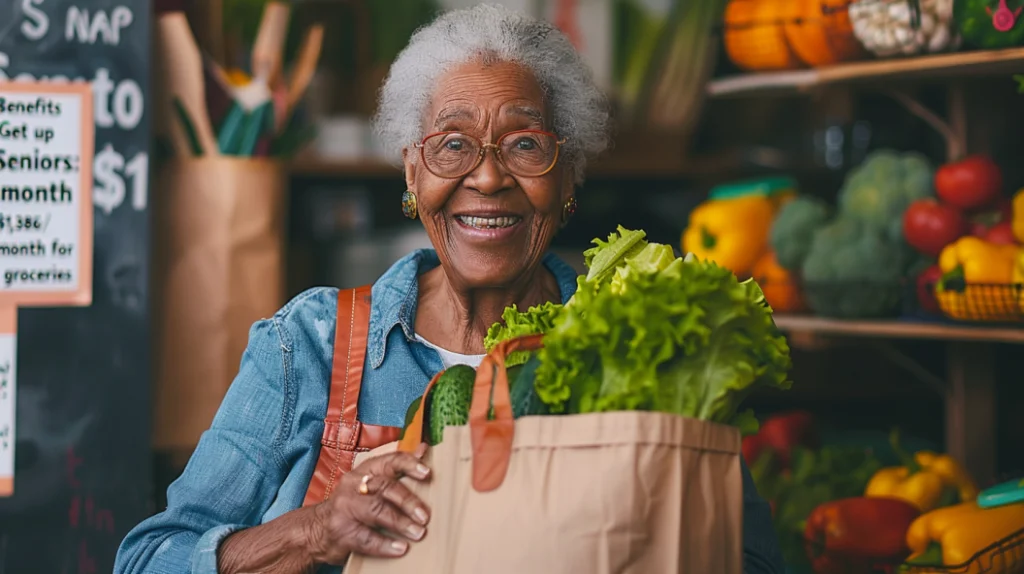Maximizing SNAP Benefits for Older Adults: A Guide to the Supplemental Nutrition Assistance Program


Older adults often find it hard to eat well and stay healthy. The Supplemental Nutrition Assistance Program (SNAP), once called the food stamp program, is a big help. This guide will show how seniors can get the most from their SNAP benefits. It helps them get the food they need to stay well.
Contents
ToggleKey Takeaways
- SNAP gives food help to low-income seniors, making sure they can buy healthy meals.
- To get SNAP, seniors must meet certain criteria like age, household size, income, and assets. There are special rules for seniors.
- Seniors could get up to $1,386 a month in SNAP benefits to help with groceries.
- Applying for SNAP can seem tough, but this guide makes it easier. It lists what documents you need and how to apply.
- Using SNAP wisely, like planning meals and budgeting, helps seniors get more food for their money. This way, they can choose healthier foods.
Understanding the Supplemental Nutrition Assistance Program (SNAP)
The Supplemental Nutrition Assistance Program (SNAP), once called the food stamp program, helps millions of Americans with low incomes. This includes older adults. It makes sure seniors and others at risk have enough food. This helps fight food insecurity and supports well-being.
What is SNAP?
SNAP is a program that gives monthly benefits for food to those who need it. It’s run by the U.S. Department of Agriculture’s Food and Nutrition Service. The program is paid for by the federal budget. SNAP helps people buy healthy food by adding to their food budget.
Eligibility Requirements for Older Adults
Older adults, those 60 or older, can get SNAP if they meet income and resource rules. They must have a monthly household income below certain limits, based on the poverty line. Some seniors on Supplemental Security Income (SSI) or certain Social Security benefits get SNAP automatically.
Eligibility for older adults can change by state. The thrifty food plan helps figure out the most SNAP benefits you can get. Seniors with low incomes and high medical bills might get more SNAP if they subtract these costs from their income.
| SNAP Eligibility Criteria for Older Adults | Details |
|---|---|
| Age | 60 years or older |
| Household Income | Must fall within program’s income limits, based on federal poverty line |
| Resources | Certain assets and savings may be counted towards eligibility |
| Automatic Eligibility | Individuals receiving Supplemental Security Income (SSI) or certain Social Security benefits |
| Medical Expense Deductions | High medical expenses may be deducted from household income, increasing SNAP eligibility and benefits |
Knowing about SNAP and its rules for older adults helps seniors get the food they need. This can improve their health and reduce food insecurity.
Up to $1,386 is Available for Groceries Every Month
The Supplemental Nutrition Assistance Program (SNAP), also known as the food stamp program, helps older adults with their grocery budgets. Those 60 or older might get up to $1,386 a month for food. This depends on their household size and income.
SNAP benefits for older adults are based on the USDA’s Thrifty Food Plan. This plan shows how much a nutritious diet costs for people and families. The plan looks at household size, monthly income, and some deductible expenses to figure out the SNAP benefit.
For instance, a single older adult with a monthly income of $1,100 might get the max SNAP benefit of $281. A married couple with a combined income of $2,000 could get up to $459 in SNAP benefits. These extra funds can greatly help older adults buy and get to healthy, nutritious food.
Older adults should know about the SNAP program and its benefits. With up to $1,386 a month for groceries, SNAP can improve food security and well-being for those with low incomes.
Applying for SNAP Benefits
Applying for Supplemental Nutrition Assistance Program (SNAP) benefits can seem hard, but it’s easier with the right info. Older adults can get this important food help by following a few steps. They need to submit the right documents and complete the application.
Required Documentation
To get SNAP benefits, older adults must collect certain documents:
- Proof of identity (e.g., driver’s license, state ID, birth certificate)
- Proof of household income (e.g., pay stubs, Social Security statements, pension statements)
- Proof of expenses (e.g., rent or mortgage payments, utility bills, medical expenses)
- Proof of assets (e.g., bank statements, retirement accounts)
These documents prove if the applicant is eligible for SNAP. They look at household size, income, and expenses.
Submitting the Application
After gathering the needed documents, the next step is to submit the SNAP application. Older adults can apply in several ways:
- Online: Many states let you apply for SNAP online, which is quick and easy.
- In person: You can go to your local SNAP office or social services agency to apply and give your documents.
- By mail: Some states let you fill out the application and send it in by mail, along with your documents.
It’s key to give all the needed info and fill out the application fully. This helps avoid delays in processing your request.
By applying for SNAP benefits and giving the right documents, older adults can get the food help they need. This helps them stay healthy and well.
Maximizing Your SNAP Benefits
As older adults, using the Supplemental Nutrition Assistance Program (SNAP) can help stretch your food budget. It ensures you have access to nutritious meals. By learning how to use SNAP benefits well, you can get the most out of this program.
Plan your meals and grocery shopping to save money. Make a budget-friendly menu with healthy, whole foods. This way, you can use your SNAP benefits better and get more nutrition from your food.
- Prioritize staple items like fruits, vegetables, whole grains, lean proteins, and dairy products to build well-balanced, cost-effective meals.
- Look for sales, coupons, and discounts to get the best prices on the foods you need.
- Consider purchasing in bulk for non-perishable items to save money over time.
Also, shop at grocery stores that offer discounts for SNAP users. Many stores give special prices to SNAP recipients. This can help you stretch your monthly benefits even more.
| Grocery Store | SNAP Benefits | Additional Discounts |
|---|---|---|
| Walmart | SNAP accepted | 5% discount for SNAP recipients |
| Aldi | SNAP accepted | 10% discount for SNAP recipients |
| Kroger | SNAP accepted | Double coupons for SNAP recipients |
Your SNAP benefits are meant to help you buy the nutritious food you need. By planning your budget, meals, and shopping smart, you can make sure your SNAP benefits support your health and well-being.
Using SNAP Benefits Wisely
As an older adult getting SNAP benefits, it’s key to make the most of your monthly money. Use smart budgeting and meal planning to make your SNAP benefits last longer. This way, you can get more nutritious and affordable food.
Budgeting Tips
Good budgeting is key to using your SNAP benefits well. Here are some tips:
- Keep track of how much you spend on food to find ways to save.
- Focus on buying healthy food that you like and need.
- Use sales, coupons, and discounts to get more from your monthly benefit.
- Look into ways to increase your SNAP benefits, like reporting changes in your income or household size.
Meal Planning and Grocery Shopping Strategies
Planning your meals and shopping smart can also help. Here’s how:
- Plan your meals ahead, choosing nutritious, budget-friendly recipes with eligible food.
- Make a detailed grocery list to avoid buying things you don’t need and get what you need.
- Check out local farmers markets, food co-ops, or food banks for affordable and nutritious food.
- Buying in bulk for non-perishable food items you use often can save you money.
By using these strategies, you can better manage your SNAP benefits. This ensures you have the nutritious food you need for a healthy life.
Supplemental Benefits for Older Adults
SNAP is a key program for older adults with low incomes. But, there are more programs and services to help them. These can improve their food security and nutrition.
Nutrition Programs and Services
SNAP-qualified older adults might also get other nutrition programs. These include:
- The Commodity Supplemental Food Program (CSFP), which sends monthly food packages to those 60 and older with low income.
- Home-Delivered Meals, or “Meals on Wheels,” which brings meals to older adults who can’t leave their homes.
- Congregate Meal Sites, where older adults can eat healthy meals and socialize at community centers.
Local and non-profit groups also offer food help for seniors. This includes food pantries, gardens, cooking classes, and rides to stores and banks.
| Nutrition Program | Description | Eligibility |
|---|---|---|
| Commodity Supplemental Food Program (CSFP) | Monthly food packages provided to low-income individuals aged 60 and older | Households with income at or below 130% of the federal poverty line |
| Home-Delivered Meals (Meals on Wheels) | Nutritious meals delivered directly to the homes of older adults who have difficulty leaving their residences | Older adults who are homebound or have difficulty preparing meals |
| Congregate Meal Sites | Communal dining opportunities at community centers, senior centers, and other locations, allowing older adults to socialize while enjoying healthy meals | Older adults who are able to leave their homes and participate in community-based activities |
These programs and services help older adults with low incomes get the nutritious food they need. This keeps them healthy and well.
Addressing Food Insecurity in Your Community
As an older adult, you can help fight food insecurity in your area. Many Americans, including seniors, struggle with not having enough food. By helping out, you can change lives and fight hunger.
Volunteering at a food bank or food pantry is a great way to help. These places need people to sort, pack, and give out food. Your help ensures that people get the food they need.
You can also give by donating food or money to help those in need. Your donations can buy groceries for families and individuals who struggle to afford them.
But there’s more you can do. You can speak up for more SNAP benefits and food help in your area. This means talking to your leaders, going to meetings, or joining discussions to help seniors and low-income folks.
By getting involved, you can help your community and work towards a future where everyone has enough food. Every bit of kindness and support counts in the fight against hunger.
Navigating
Navigating the SNAP program can seem tough, but it’s easier with the right info and help. Older adults can get the benefits they need by understanding how to apply. The application process changes by state, so it’s key to know what’s needed and where to get help.
The SNAP outreach program is a big help, offering personalized advice to those who qualify. These workers can guide older adults through the process. They help figure out if you’re eligible, collect the needed documents, and fill out the application. Also, local groups like senior centers and community organizations have staff ready to help with SNAP enrollment.
If you like to do things on your own, there are online tools and resources. The SNAP eligibility calculator on the USDA website can show you what benefits you might get. State SNAP websites have all the details on applying and what documents you need.
Latest News
-
Ways to Avoid Lifestyle Creep
Blog | 06/30/2025 -
How to Review Your Budget Monthly: A Simple Guide
Blog | 06/30/2025 -
How to Save Money While Trying to Get Out of Debt
Blog | 06/29/2025






